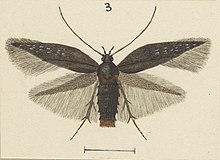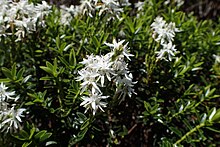| Scythris nigra | |
|---|---|

| |
| Male holotype | |
|
Scientific classification
| |
| Domain: | Eukaryota |
| Kingdom: | Animalia |
| Phylum: | Arthropoda |
| Class: | Insecta |
| Order: | Lepidoptera |
| Family: | Scythrididae |
| Genus: | Scythris |
| Species: | S. nigra
|
| Binomial name | |
| Scythris nigra
Philpott, 1931
| |
Scythris nigra is a species of moth in the family Scythrididae first described by Alfred Philpott in 1931. [1] It is endemic to New Zealand. The larvae of this species feeds on Hebe odora. The adults are day flying and on the wing in December.
Taxonomy
This species was first described by Alfred Philpott in 1931 using specimens collected on Maungatua in December by C. E. Clarke. [2] The male holotype specimen is held at the Auckland War Memorial Museum. [3]
Description

Philpott described this species as follows:
♂. 12 mm. Head, palpi, abdomen and thorax dark purplish fuscous. Antennae purplish fuscous, ciliations in ♂ ½. Legs dark purplish fuscous, tarsi without annulations. Forewings with costa moderately arched, bent at ⅓, apex acute, termen extremely oblique; dark purplish fuscous sparsely sprinkled with white scales: fringes dark fuscous. Hindwings and fringes dark fuscous. [2]
This species can be distinguished from the similar appearing S. triatma as it has a much darker appearance and lacks the bluish-slate colour that can be seen on the fore-wings of S. triatma. [4]
Distribution
This species is endemic to New Zealand and has been observed in the lower parts of the South Island. [5] [4]
Behaviour
The adults of this species are day flying and on the wing in December. [4] [6]
Habitat and hosts

S. nigra normally lives in alpine habitats however it can be also found at relatively low altitudes such as at Waitahuna Hill]] near Lake Mahinerangi. [7] The larvae of this species feed on Hebe odora. [8]
References
- ^ Gordon, Dennis P., ed. (2010). New Zealand inventory of biodiversity: Kingdom animalia: chaetognatha, ecdysozoa, ichnofossils. Vol. 2. p. 463. ISBN 978-1-877257-93-3. OCLC 973607714. OL 25288394M. Wikidata Q45922947.
- ^ a b Alfred Philpott (1931). "Notes and descriptions of New Zealand Lepidoptera". Transactions and Proceedings of the New Zealand Institute. 62: 31. ISSN 1176-6158. Wikidata Q109466059.
- ^ John Stewart Dugdale (23 September 1988). "Lepidoptera - annotated catalogue, and keys to family-group taxa". Fauna of New Zealand. 14. Department of Scientific and Industrial Research: 110. doi: 10.7931/J2/FNZ.14. ISSN 0111-5383. Wikidata Q45083134.
- ^ a b c George Vernon Hudson (1939), A supplement to the butterflies and moths of New Zealand, Illustrator: George Hudson, Wellington: Ferguson and Osborn Limited, p. 459, OCLC 9742724, Wikidata Q109420935
- ^ "Scythris nigra Philpott, 1931". www.nzor.org.nz. Retrieved 2022-05-05.
- ^ Brian Patrick (1 December 2014). "Conservation status of five data deficient moth taxa: Epichorista lindsayi, "Cnephasia" paterna, Stathmopoda endotherma, Gymnobathra ambigua and Scythris "stripe"". The Wētā. 48: 15–34. ISSN 0111-7696. Wikidata Q105343576.
- ^ Department of Conservation (New Zealand) (2016). CMS, conservation management strategy. Otago 2016 (PDF). Christchurch: Department of Conservation. p. 94. ISBN 978-0-478-15089-6. OCLC 978282663.
- ^ K. J. M. Dickinson; A. F. Mark; B. I. P. Barratt; B. H. Patrick (March 1998). "Rapid ecological survey, inventory and implementation: a case study from Waikaia Ecological Region, New Zealand". Journal of the Royal Society of New Zealand. 28 (1): 142. doi: 10.1080/03014223.1998.9517556. ISSN 0303-6758. Wikidata Q54578259.